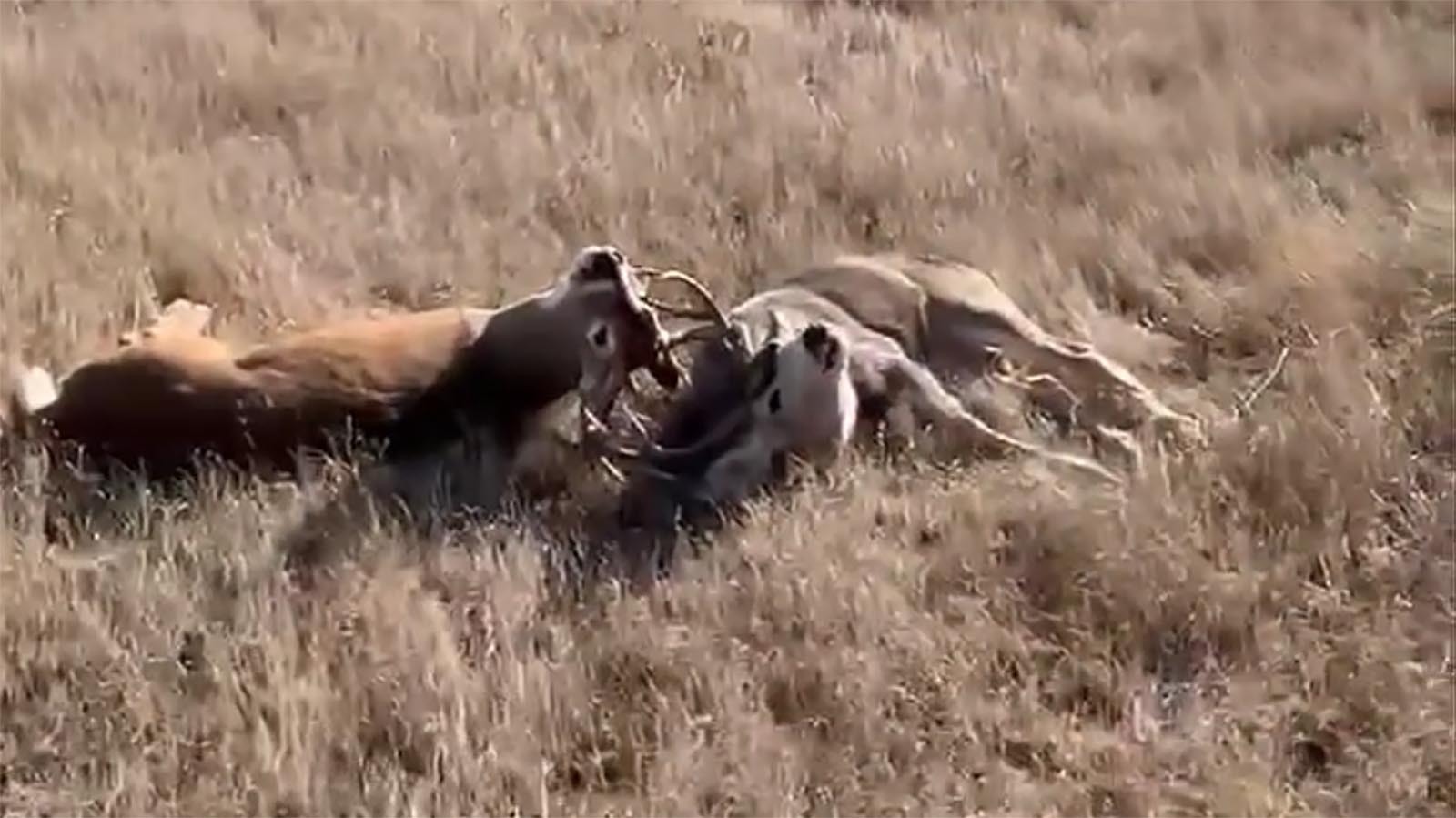Wyoming
Blue hydrogen could be Wyoming's net-zero solution, study suggests

LARAMIE, Wyo. — As global needs for more environmentally sustainable energy solutions grow, Wyoming’s chief industry, energy extraction, is at danger of being left to dry. However, a new study published by University of Wyoming researchers theorizes that the state might find its solution in hydrogen.
The study, authored here in Wyoming by a range of contributors from UW and state community colleges, suggests that a possible solution for Wyoming becoming a net-zero emissions economy lies in the often environmentally scrutinized natural gas industry.
Blue hydrogen is an energy resource sourced from natural gas production using a process called steam methane reforming that would be paired with carbon capture and storage. Like natural gas itself, blue hydrogen has a large range of electrical and energy uses. Importantly, it is much cleaner than pure natural gas.
The study then suggests that Wyoming could use the resource as its key to staying at the forefront of the country’s energy economy while still prioritizing net-zero emissions goals.
How does steam methane reforming work?
According to the United States Office of Energy Efficiency and Renewable Energy, SMR is an energy production process that attaches itself to already existing natural gas production infrastructure.
Natural gas’ primary composition is methane, which is made of carbon and hydrogen molecules. By heating methane gas through thermal processes like steam power, the gas breaks up into its primary components.
Methane (CH4) contains more hydrogen than carbon, but carbon monoxide and carbon dioxide, which is a greenhouse gas, are still produced nonetheless. According to the study, SMR paired with carbon capture would alleviate greenhouse gas production during this process.
Notably, blue hydrogen is not actually the cleanest form of hydrogen gas production. Another process called renewable-powered electrolysis produces a cleaner form of hydrogen gas referred to as green hydrogen. However, the study authors point out that the production cost of green hydrogen is much higher than its blue counterpart and is less feasible for the state to produce en mass.
Wyoming’s unique position; what to gain
According to the study, Wyoming especially lends itself to being a potential key player in the production of the resource for a number of reasons. For one, blue hydrogen production runs on extant natural gas infrastructure, which Wyoming has. The Petroleum Association of Wyoming reports that in 2022, the state had around 17,800 gas producing wells.
A pro-energy regulatory environment that the state has fostered over the years is also an attractive factor to the industry, the study authors suggest. The study points to legislation such as the state’s Low-Carbon Energy Standards as being favorable for the resource’s growth here in the Cowboy State.
Federal tax incentives laid out by the Inflation Reduction Act would furthermore economically benefit the state if blue hydrogen production was kickstarted here.
Another potential benefit to this extraction method would be how it could stimulate the workforce economy within the state. At a time where the energy industry is often at odds with the federal regulatory environment, a new perspective on energy production could keep students studying here in Wyoming and getting oil and gas jobs in-state.
Researcher and UW Hydrogen Energy Research Center Director Eugene Holubnyak said in a UW Institutional Communications release that the benefits to Wyoming citizens was a factor in the paper.
“This study really allowed us to incorporate the views of the community colleges and explore some of the economic incentives and workforce training opportunities for a natural gas-based, low-carbon hydrogen industry,” Holubnyak said.
Resource and infrastructure requirements
Where it gets complicated is that coupling carbon capture and storage with MSR in hydrogen gas production is costly and sucks up water resources.
Hydrogen gas production isn’t an unheard of process. Currently, according to the study authors, 95% of the country’s hydrogen is produced through SMR. However, all of that is done so without the additional process of storing the carbon byproducts. Hydrogen produced this way, in keeping with the color trend, is called gray hydrogen.
Blue hydrogen production is 55% more expensive overall and increases water withdrawal intensity by 87%. The decision to prioritize blue hydrogen over gray hydrogen or natural gas would therefore be a weighty one.
Using National Energy Technology Laboratory assessments, adjusting them to the Wyoming economy and then factoring in the possible benefits from IRA tax credits, the authors did find that the state could be in a beneficial position if it began implementing plant-scale hydrogen production.
Put to an actual number, the study suggests that the state could up to $2 per kilogram of low-carbon hydrogen if captured carbon byproduct is properly stored in saline reservoirs. With the tax credits that would subsequently follow, the state would also earn $85 per metric ton of carbon dioxide captured.
Not dismissing the economic potential of green hydrogen, which sells for at least $3 per kilogram, the study authors say both could ultimately have a solid future in Wyoming.
“As Wyoming has abundant natural gas and wind resources, blue and green hydrogen can be options in the near and long terms to create new jobs and diversify the state’s energy-driven economy, respectively,” according to the study.
Related

Wyoming
City receives over $8M in grant funding from Wyoming Office of Outdoor Recreation

CHEYENNE, Wyo. — Projects in the City of Casper have received funding amounting to over $8 million.
On Friday, the Wyoming Office of Outdoor Recreation announced it had dispersed awards to various programs and initiatives across the state as part of its ARPA Grant Program, which has allocated an additional $17,719,899 in funding. To date, the grant program has awarded $20,332,258 for 21 outdoor recreation projects across the state.
The City of Casper received grant funding for three projects: improvements for Marion Kreiner Pool and Park, the North Casper Athletics and Recreation Complex and North Platte River Pedestrian Bridge. Altogether, the Oil City received $8,195,000 for the projects.
“We are excited to make improvements to Marion Kreiner Pool and bring a skate park and pump track to the adjoining park that will serve skateboard, scooter, and bicycle riders,” said Zulima Lopez, Casper Parks, Recreation, and Public Facilities director. “When coupled with Matt Campfield Park just one block north, this project will create a hub of recreational opportunities and community activities that will benefit the residents of North Casper, especially the youth.”
The following grant applications were approved during the second and final round of funding:
- $182,710 for Albany County Board of Commissioners’ Pilot Hill Schoolyard Trail Maintenance
- $1,850,000 for the City of Casper’s Marion Kreiner Pool and Park Improvements
- $2,845,000 for the City of Casper’s North Casper Athletics and Recreation Complex Improvements
- $3,500,000 for the City of Casper’s North Platte River Pedestrian Bridge
- $2,479,705 for the City of Laramie’s Spring Creek Trail Phase 2
- $1,393,817 for the City of Laramie’s LaBonte Park Pathway and Fitness Trail Improvements
- $743,849 for the City of Rock Springs’ Century West Park Pool/Sprayground Renovation
- $290,000 for the Cheyenne Children’s Museum’s CCM Community Space
- $410,000 for the Northern Arapaho Tribe’s Ethete Powwow Arbors
- $1,145,106 for the Wind River Development Fund’s Eastern Shoshone Playgrounds
- $78,100 for the Wind River Development Fund’s Outdoor Sports
- $508,483 for the Wind River Development Fund’s Powwow Arbor
- $333,289 for the Wind River Development Fund’s Tribal Buffalo Initiative
- $1,168,539 for the Wind River Development Fund’s Wind River Lakes
- $791,301 for the Wind River Development Fund’s WRR Trailheads
“These grants represent a significant investment in our communities and outdoor spaces, providing vital opportunities for recreation, health, and connection to nature,” said Brynn Hirschman, grants coordinator for the Wyoming Office of Outdoor Recreation. “We are thrilled to support projects that will enhance the quality of life for residents and visitors alike, while fostering economic growth through outdoor recreation.”
During its second round of applications, the office received 33 applications from local, county, state and tribal governments, as well as nonprofit organizations. The total requested funding equaled $47,839,730, exceeding the office’s available funds by $26,452,089.
The funds are made available through the American Rescue Plan Act, or ARPA, and Local Fiscal Recovery Funds, appropriated by the Wyoming Legislature and approved by Gov. Mark Gordon. The Wyoming Outdoor Recreation ARPA Grant Program was created to fund public outdoor recreation projects throughout the state. To be eligible, a project must occur within a Qualified Census Tract or Disproportionately Impacted Community as determined by the U.S. Treasury. The full impact of these grants will be realized over the coming years as these recreational projects are developed.
“The Jay Kemmerer WORTH Institute at the University of Wyoming is conducting an economic impact study of both the round one and two Wyoming Outdoor Recreation ARPA Grants,” said Dan McCoy, director of the WORTH Initiative. “Our economic impact study should help decision-makers better understand the total economic payoff for these investments. However, communities will also receive other benefits from these projects including better mental and physical health outcomes from greater access to the outdoors.”
For more information about the Wyoming Office of Outdoor Recreation and future funding opportunities, click here.
Related
Wyoming
Rare Whitetail-Mule Deer Fight Highlights Conflict Between Wyoming Species

A video recently shot in South Dakota of a mule deer and whitetail buck that fought until they fell over in complete exhaustion encapsulates a region-wide conflict between the species.
In the bigger picture, whitetail seem to be winning the war, but at least in northeast Wyoming, mule deer won a battle.
That’s thanks to disease, Wyoming state Sen. Ogden Driskill, R-Devils Tower, told Cowboy State Daily.
“I have maybe 50 whitetails left on my property, and the mule deer are coming back. They’re a welcome sight. They do way less crop damage,” said Driskill, whose family’s ranch is right next to Devils Tower National Monument.
A recent outbreak of epizootic hemorrhagic disease, commonly called blue tongue, hammered whitetail in the region, but didn’t badly affect mule deer, he said.
That could mean that the muley victory will be short lived, Driskill said, because whitetail breed like rabbits.
“Whitetail are like a weed,” he said. “Once they take hold, they have twins and triplets, and they’ll just take over an area.”
Bucks Duke It Out
Driskill has run the family ranch for 50 years, and said he’s watched whitetails and mule deer clash from time to time.
But for bucks of the two species to get into an all-out battle to the finish is rare, he said.
As to why the bucks in South Dakota brawled, it might have been because of a severe shortage of does during the rut or deer mating season, he said.
Generally speaking, mule deer and whitetail stick to their own kind when it comes to mating – and to bucks clashing over who gets access to does.
However, the two species do occasionally cross-breed, producing rare hybrid offspring.
The video, posted online by Buckstorm outdoors media, shows the whitetail and mule deer bucksflopped over on their sides with their antlers locked together. The bucks are completely exhausted from what must have been a prolonged battle.
The bucks were separated, and both limped away, but it’s not known if either of them lived, according to Buckstorm.
In a text message to Cowboy State Daily, a Buckstorm representative said that the video was shot on private property in South Dakota, and the landowners didn’t want to be named.
‘Whitetail Are More Aggressive’
Driskill said that on his property and across the Black Hills in Wyoming and South Dakota, “mule deer and whitetails are in direct competition.”
And overall, whitetail have the edge, he said. Even though whitetails are the smaller of the two species, they’re scrappier.
“Whitetail are more aggressive than mule deer and they tend to habituate toward people a lot better,” he said.
That’s why he worried that the mule deer victory he’s seen in the wake of the blue tongue outbreak won’t last.
Split The Tags?
Northeast Wyoming has some prime mule deer habitat. And rich nutrients in the soil there could produce some monster bucks, Driskill said.
But he thinks the Wyoming Game and Fish’s approach to deer management there isn’t working.
In much of the region, hunters can get a general (over-the-counter) deer tag and kill whichever species they like, he said. And out-of-state hunters in particular like to kill mule deer.
“There’s whitetail hunting opportunity all over the country, but this is one of the few places with mule deer hunting opportunity,” Driskill said, so non-resident hunters relish the chance to get a muley.
Driskill has advocated for splitting the hunting tags for mule deer and whitetails and managing the species separately.
“The whitetail tag should be over-the-counter, and the mule deer tags ought to be draw tags,” he said.
General, or over-the-counter deer tags may be purchased at any time. For limited quota draw tags, hunters must apply months in advance, and not all hunters who put in for tags will draw them.
Driskill backed legislation to split mule deer and whitetail tags during the Legislature’s 2024 session, but that bill failed.
He said he doesn’t plan to introduce a similar bill during the upcoming 2025 session.
But Game and Fish should still consider separate management for the two species, at least in northeast Wyoming, he said.
“If Game and Fish worked on it, northeast Wyoming would really be known for mule deer,” he said. “The mule deer are surging on my ranch. And they’ll only surge as long as whitetail deer are scarce.”
Mark Heinz can be reached at mark@cowboystatedaily.com.
Wyoming
Experts say immigrants are important in state, Jackson Hole economy

The Jackson Hole Chamber of Commerce isn’t reacting yet to a second election of President-elect Donald Trump.
Rick Howe runs the chamber and told Jackson Hole Community Radio in December that three chamber businesses had reached out to him with immigration-related concerns. Howe does not soon anticipate the chamber taking a stance on immigration policies. But he said his policy teams are preparing to discuss changes as they come, such as mass deportations.
“We want to make sure that we have access to the workers that we need as a community to help us continue to do what we do on a daily basis,” Howe said. “Economic viability is key for us.”
He said he doesn’t have up-to-date data on the community’s number of working immigrants — documented or otherwise. But he said immigrants mostly work in the tourism and service industries, Teton County’s economic engine.
For Teton County and surrounding communities, how many immigrants would be targeted in a second Trump administration is still unknown.
But as Trump prepares to return to the White House, the question of how many will be impacted by his policies has become increasingly relevant for immigrants from many walks of life.
Trump’s administration promises the largest mass deportation in the country’s history, after the Biden administration’s deportations already hit a 10-year high. As summarized by the Niskanen Center, a potential policy playbook for the second Trump term, Project 2025, proposes cutting protections for holders of Temporary Protected Status, young adults known as Dreamers, more than 175,000 Ukrainians, in addition to restrictions for H-2A and H-2B temporary worker visas.
For unauthorized immigrants and migrants, part of what makes the population hard to track is obvious: They aren’t documented in the U.S. census. The census doesn’t separate documented and undocumented residents — it just totals.
University of Wyoming Professor Roger Coupal researches the economics of community developments across the state, with a focus on the agricultural sector. He has some rough estimates, putting the state’s number of undocumented migrants at 5,000.
Teton County, according to the U.S. census, is home to 2,900 residents born outside the U.S., or 12.5% of the county’s population. Just under a third have become naturalized citizens, according to the state’s Chief Economist Wenlin Liu.
Coupal noted that many who come to the U.S. are fleeing “extreme situations” when they come to Jackson in search of work or safer living conditions. As more immigrants settle and become part of the community and economy, many ski towns in the West, including Jackson Hole,could be devastated by mass deportations, he added.
Until new policies or deportation practices exist, though, Howe said his organization would be proactive. It’s a lot of “wait and see” until January, he said.
Howe envisions the chamber’s role as a source of information and connection.
He mentioned other nonprofits like Voices JH and One22, with whom the chamber could facilitate conversations, correct misinformation and be a source to which individuals and businesses alike can turn.
To start, the chamber is planning a Feb. 6 “Business Over Breakfast,” a monthly networking event for members, to address questions businesses may have a few weeks into Trump’s second administration.
Coupal said a loss of migrant workers and Trump’s impending tariffs could thrust the country into a recession.
“You could see a reduction in output on the industry side because we don’t have workers,” Coupal said.
There’s no research, he said, that supports Trump’s previous claims that immigrants hurt the economy.
A recent report by the American Immigration Council said mass deportation would cost the U.S. $315 billion initially, with long-term costs potentially tripling.
Jeremy Robbins, executive director of the American Immigration Council, said in a recent press release that mass deportation would come at an “extraordinary cost” to the government while hindering the economy. He warned of “tens of billions of tax-payer dollars lost, already-strained industries devastated, millions of people locked up in detention, and thousands of families torn apart.”
The study also indicates that national GDP could shrink 4.2% to 6.8%. For comparison, the economy decreased by 4.3% during the 2007 to 2009 recession, according to the study.
“We’re making the assumption that somehow Americans are going to replace all these people,” Coupal said, “and they won’t.”
-

 Business1 week ago
Business1 week agoOn a quest for global domination, Chinese EV makers are upending Thailand's auto industry
-

 Health6 days ago
Health6 days agoNew Year life lessons from country star: 'Never forget where you came from'
-
/cdn.vox-cdn.com/uploads/chorus_asset/file/24982514/Quest_3_dock.jpg)
/cdn.vox-cdn.com/uploads/chorus_asset/file/24982514/Quest_3_dock.jpg) Technology6 days ago
Technology6 days agoMeta’s ‘software update issue’ has been breaking Quest headsets for weeks
-

 World1 week ago
World1 week agoPassenger plane crashes in Kazakhstan: Emergencies ministry
-

 Politics1 week ago
Politics1 week agoIt's official: Biden signs new law, designates bald eagle as 'national bird'
-

 Business3 days ago
Business3 days agoThese are the top 7 issues facing the struggling restaurant industry in 2025
-

 Politics1 week ago
Politics1 week ago'Politics is bad for business.' Why Disney's Bob Iger is trying to avoid hot buttons
-

 Culture3 days ago
Culture3 days agoThe 25 worst losses in college football history, including Baylor’s 2024 entry at Colorado















